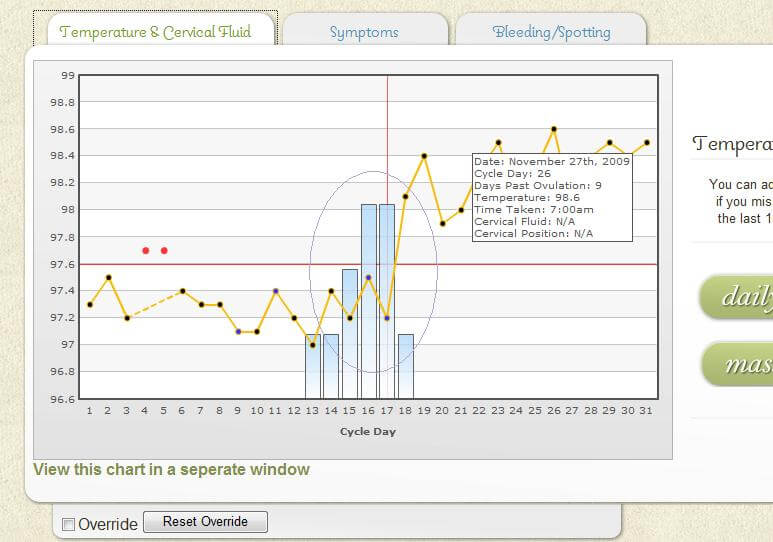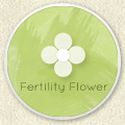Charting Primer: Using the Sympto-Thermal Method to Predict Ovulation

Guest Post Written by Kimberly Racic
Hi, I’m Kimberly and I’m behind a project called Fertility Flower. Stephanie asked me to prepare a primer on fertility charting using the Sympto-Thermal method and I was happy to oblige.
First off, let me say that charting is really, really easy. Once you get the fundamentals down, it becomes second nature.
Charting is also incredibly valuable. It can be used to maximize the chances of a pregnancy or it can be used to avoid a pregnancy naturally without chemicals or barriers. The goal is the same in both scenarios – identify when ovulation is about to happen and then act accordingly.
Along the way, you’ll gain invaluable knowledge about your body and learn what ˝normal˝ is for you. I’ve even been known to take my charts with me to the doctor’s office because when you’re charting, you’re forming a picture of what your hormones are doing (or sometimes NOT doing). You can imagine the power in that.
So, let’s get to it!
The Tools (What You Need):
:: A Basal Body Thermometer
(Confession time…I use a regular fever thermometer. tsk, tsk…I know, I know. But understand this, the point is not so much what your temperature is as is the pattern that will emerge over the course of the month. Low temperatures versus high temperatures.
But whatever you use, make it digital. Di.Gi.Tal! You can’t be shaking down a glass thermometer right when you wake up or this method won’t work).
And…that’s it. That’s all you need, a DIGITAL thermometer.

Image by tessawatson
The Method:
Since we’re talking about something called the Sympto-Thermal method, there’s a symptoms part and a temperature part.
Let’s talk temperature, first…
First thing when you wake up, you take your temperature. Take that temp before you really even move. I’m often half asleep – THAT’s how much you don’t move. Don’t get up and go to the bathroom. Don’t talk. Don’t do anything. Just put a thermometer in your mouth. This is the basal body temp (think: ˝base˝ temperature).
After your DIGITAL thermometer bleeps at you, you can move. In fact, grab a pen and write that temperature down in case you forget it, although most modern digital thermometers have some memory in them (but check first, just in case).
Next…Cervical Fluid
Go to the bathroom. In the bathroom, check your cervical fluid. Look on your underpants….look on the toilet paper… or if you’re willing, check internally by using your index and middle finger to draw out the fluid from the cervix. Note the quality of the cervical fluid. Is it sticky? Creamy? Watery or something that resembles raw egg white?
Each one of these tells you about your current fertility˝status˝ and how close you are to ovulation. Wetter is better for conception purposes.
Now what?
Chart your temperature. The vertical axis is the temperature. The horizontal axis is the cycle day (cycle day 1 is the first day of your period). Day after day, plug your temperature into your chart and watch what emerges. You’ll notice that month after month, your waking temperature follows a pattern.
A pattern like this (the yellow line/graph):

From the first day of your period until ovulation your temperature will remain relatively low. How low, you ask? That depends on you. I tend to run cool…from 95.8 to 96.3F in the pre-ovulatory stage. Once ovulation happens, your waking temp zooms up and STAYS UP until your next period.
Note your cervical fluid. At Fertility Flower, we chart temperature and cervical fluid in the same space because these things are related so it makes sense to keep these two signs together. As you approach ovulation, your cervical fluid will become wetter, more slippery (denoted here by higher and higher blue bars on the bar chart). The typical pattern is to go from dry (no cervical fluid)…to sticky…to creamy…to watery or something resembling raw egg white. You’ll be able to stretch the egg white cervical fluid between your thumb and index finger – a phenomenon called ˝spin˝.
Once you start noticing cervical fluid, these are the days that you should aim to take advantage of if your goal is to achieve a pregnancy or abstain if you’re aiming to avoid a pregnancy naturally (without chemicals or barriers).
Finally… Analyze
The last day of your wettest cervical fluid while your temperatures are still low is called your peak day. If all goes well, you’ll ovulate at some point during this 24-hour period. This is THE BIG DAY, folks, and the one that you definately want to take advantage of if you’re looking to become pregnant.
You’ll be able to confirm ovulation IF the morning after your peak day, you see that your temperature zoomed up AND IF IT STAYS UP FOR 3 DAYS IN A ROW. Only when these two conditions are satisfied can you be confident that you’ve ovulated.
And then you are welcomed into the world of the ˝Two Week Wait˝ which brings with it a state of neurosis called ˝symptom watching˝. Just kidding (sort of).
Note: If your temperature doesn’t stay up for three days, you’re still potentially fertile (might be due to a delayed ovulation cause by stress or sickness or whatever) so keep trying until you see your temperature shift….it might be on cycle day 14…16…26…etc…
If pregnancy is the goal, all the books will tell you to wait to take a pregnancy test until the 18th day past ovulation. But I know that you’ll start testing much sooner. My advice would be to save yourself a lot of worry and a little cash and wait until at least day 13 or 14. In all three of my pregnancies, I’ve gone positive on day 16 – and not a minute sooner.
 Kimberly Racic is the founder of Fertility Flower. Fertility Flower is a membership-based website that is designed to help women who are trying to conceive through the completely natural Sympto-Thermal method. The website will launch in July but is already the biggest fertility charting site on Facebook with over a 1,100 Likeronies.
Kimberly Racic is the founder of Fertility Flower. Fertility Flower is a membership-based website that is designed to help women who are trying to conceive through the completely natural Sympto-Thermal method. The website will launch in July but is already the biggest fertility charting site on Facebook with over a 1,100 Likeronies.





Interesting read…
I just want to share a quick adage that I’ve heard somewhere…that has always helped me.
If you’re dry (cervical fluid) the sperm will die,
If you’re wet, a baby you wil get.
Also: Side note. You can find Pregnancy Tests at a $$ store and pay only a dollar for something that works just as effective as a more expensive test out there. Just FYI for anyone interested…
@Bevy, Oh my gosh, that’s a great adage!!!
Charting really is very easy, and just like the article says, once you get the hang of it, it is like second nature! I used the book “Taking Charge of Your Fertility” to learn about charting and have recommended it to many friends since. I’m always a little surprised that when asked by health professionals what “birth control” method we use and I say I chart my cycles, many of them have no idea what I’m talking about. Most assume I mean the rythm method. Very different!
I have used this method too, but right now am not since I am waking up a lot at night (due to health issues) and breastfeeding too which makes it hard.
However its a GREAT method and I highly recommend it, even just to understand your body.
When I use it, I use a digital thermometer with a “memory” so I can take my temp, let it beep, set it on the bed side table, and go back to sleep if I want to like on a Saturday when our family sleeps in a little later. Very helpful.
I used the book “Taking Charge of Your Fertility” as well. After charting I was able to get pregnant with my two children very easily. Charting may seem like a hassle at first, but it really doesn’t take much time…and it really works!
.-= Laryssa @ Heaven In The Home´s last blog ..Simplify Your Summer =-.
@Laryssa @ Heaven In The Home, It’s true that there is a learning curve, but I found that once I ˝got it,˝ knowing what was going on with my body was so liberating.
This might be just what I need to get back into charting! We used the sympto-thermal method for the first 6 months of our marriage before throwing the “rules” out the window and getting pregnant. 🙂 I just haven’t gotten back around to it since baby came 2 years ago… and really would like to. Anyone know how much the membership will cost for Fertility Flower?
@Amanda, well, we’re going to be beta testing the website in a couple weeks (in which you’re welcome to participate). This is, of course, free of charge. Then as part of the regular offering, you receive a free trial month. My advice would be to become a fan of our facebook page (www.facebook.com/FertilityFlower) so that you’re notified when the site is live. As for the regular price, everyone will have full information once the website is live. Hope that doesn’t irritate you too much 🙂 but I think it’s better this way. Otherwise, there’s the risk of having the information trickle out in dribs and drabs and end up wrong as it moves through the grapevine 🙂 But I’ll tell you that we’re competitive.
You can save money by not buying a pregnancy test at all. I have two children and I have not bought pregnancy tests. I have the Couple to Couple League book and it says that if your temperatures stay up for 21 days (or 7 days longer than they usually stay up), then there is a very high probability of pregnancy.
@Kristina, you’re exactly right. There’s a rare exception where this isn’t true…it’s rare…and that is a corpus luteum cyst. As luck would have it, I ended up with one of those for a cycle….a cycle that ended up 54 days long as a result. But generally yes, they say that even if your temperature stays up for 18 days in a row the likelihood is very high that it’s because of a pregnancy 🙂
I used this method and I got pregnant the first month I did it! Yippee!
.-= Angela´s last blog ..Gratituesday =-.
I’m so glad this is becoming more well known! Most people look at me like I’ve fallen off the rocker when I tell them I’m not using any “traditional” birth control. Before we were spending $360 a year on birth control…now I replace my thermometer’s battery every 8 months or so for $5! Good luck with your website and keep spreading the news!
.-= Kait Palmer´s last blog ..Locks and Cops and Grumps- Oh My- =-.
@Kait Palmer, Thanks! You wouldn’t believe how much fun I’ve had putting this project together!
I’m not an STM user but I’m a NFP momma! We didn’t start using a fertility based method until after we had our 3rd child, we since planned our 4th with the help of charting & avoided before his arrival & since. That’s what is great you learn SO much about your body & fertility. I’m so glad to see more sites & people out there to help women (and their partners!) learn how to accurately use them 🙂
.-= beth aka confusedhomemaker´s last blog ..No Worries Just Chillin’ =-.
I’m about to have our second baby (I’m currently a week overdue!), and I’m wondering how this method works postpartum. Does it work? Do I just start taking my temp from the time we decide to have sex again after the birth? Will it be accurate?
.-= Beth´s last blog ..Waiting for Labor to Begin =-.
Thanks for the post, long-term NFP user here! The more awareness about this healthy method, the better!
Kim, I just wanted to mention something about low temps. . . have you checked yourself for hypothyroid symptoms? It’s something I’m in the middle of figuring out about my own low temps.
HTH!
Rebecca
Awesome article! I had read about a method similar to this in another book a couple years ago. We got lazy and stopped charting or just loosely charted the mucus, but not with the temperature.
So glad to see how it was explained so easily and clearly. Great refresher for me. Perhaps i should try this again 🙂
and a note after reading the last comment. i have hypothyroidism and am in the middle of getting the right dosage of meds to get a good level. I was a good level for a few years and all of a sudden level went wacko on me. i wonder how this would affect the basal temperature.
@jennifer daughtry,
I’m no expert, but I would think your temps would be somewhat unreliable if your thyroid isn’t stable.
I’m using the info at Stop the Thyroid Madness to get treatment. . . you may want to check it out if you’ve been using Synthroid or T4-only meds, as those don’t work long-term since they don’t fully support your thyroid. The website recommends desiccated thyroid to treat properly. Maybe that will help.
Rebecca
I am new to this method and am trying to get started…maybe this is a silly question, but I understand cycle day 1 is the first day of your period-so is that also when I would begin my charting and temperature taking?
Any other advice or information about getting started would be much appreciated 🙂
Thank you!
@Lorissa, Yes, that’s right. Everything starts on Day 1, first day of period. But if you need to, you can jump into charting at any point in your cycle, it might just be a bit more confusing to know exactly where you’re at if you’re just learning how to do it.
@Stephanie @ Keeper of the Home, Great! Thank you for your help Stephanie!
There are slightly different methods of calculating due dates. And ultrasounds go by measuring growth, and they are NOT so precise that they can nail down the exact date of conception, early pregnancy scans have a margin of error of up to a week.
Charting really is very easy, and just like the article says, once you get the hang of it, it is like second nature! I used the book “Taking Charge of Your Fertility” to learn about charting and have recommended it to many friends since. I’m always a little surprised that when asked by health professionals what “birth control” method we use and I say I chart my cycles, many of them have no idea what I’m talking about. Most assume I mean the rhythm method. Very different!
When is the earliest time that you can take a pregnancy test? I just got married 2 months ago and my body is adjusting to my husband still, if you know what I mean! My breasts are sore, I’ve been nauseas off and on randomly, and have some lower back tightness randomly as well. My cycle is 27-30 days and I’m on day 16 since the start of my first cycle. We loosely chart symptothermal but need to start charting more seriously. Any tips? Either way this is an exciting process!